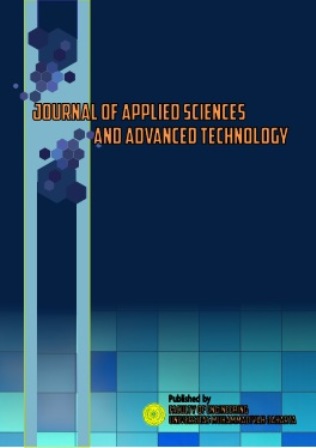Simulation Study for Syn-Gas Productivity of Open Top Downdraft Gasifier Using Wood Sawdust Feedstock by ASPEN Plus
DOI:
https://doi.org/10.24853/jasat.5.2.51-58Kata Kunci:
Biomass Wood Sawdust Open Top Downdraft Gasifier ASPEN Plus Syn-GasAbstrak
Wood sawdust feedstock is one of commodity of furniture industrial waste in Indonesia. It could be used for biomass feedstock for syn-gas producing with gasification process. Wood sawdust could be alternative ways for replacing other biomass feedstock that hard to find for biomass gasification processing, it has good high heating value (HHV) of abouts 18.75 MJ/kg. Besides that open top downdraft gasifier is one of a kind biomass gasifier/reactor for syn-gas producing. It had better with the other gasifier for syn-gas producing; such as cross draft gasifier and updraft gasifier because for micro-grid electricity it has lower cost for designing and maintaining. Syn-gas is a synthetic gas that contains several elements of hydrocarbons, such as CO (carbon monoxide), CH4 (methane) and H2 (hydrogen). It could be useful for combining with internal combustion engine for producing micro-grid electricity. Syn-gas could be alternative fuel to replace gasolines or diesels fuel for internal combustion engine that converted to electrical generator as prime mover power. At this simulation study we get the result of mole fractions for syn-gas productivity from wood sawdust feedstock by using ASPEN Plus software is CO (1.622%), CH4 (6.722%), H2 (12.448%). At the end of the calculations we get HHV of syn-gas is 4.47 MJ/Nm3, gasification efficiency (Xcge) is 20% and amount of carbon in wood sawdust that convert to gaseous (Xc) is 0.43%. Simulation study by using ASPEN Plus software could be more useful for resulting syn-gas productivity without any problems. For academic communities, simulation study by using software could be solutions when we have no more cost for practicing in the workshop.Unduhan
Referensi
Bukar, A. A., Ben Oumarou, M., Tela, B. M., Eljummah, A. M., & Oumarou, M. Ben. (2019). Assessment of Biomass Gasification: A Review of Basic Design Considerations "Assessment of Biomass Gasification: A Review of Basic Design Considerations. American Journal of Energy Research, 7(1), 1–14. https://doi.org/10.12691/ajer-7-1-1
Costa, M., Massarotti, N., Cappuccio, G., Chang, C. T., Shiue, A., Lin, C. J., & Wang, Y. T. (2014). Modeling of syngas production from biomass energy resources available in taiwan. Chemical Engineering Transactions, 37, 343–348. https://doi.org/10.3303/CET1437058
Gagliano, A., Nocera, F., Bruno, M., & Cardillo, G. (2017). Development of an equilibrium-based model of gasification of biomass by Aspen Plus. Energy Procedia, 111, 1010–1019. https://doi.org/10.1016/j.egypro.2017.03.264
González-Vázquez, M. P., Rubiera, F., Pevida, C., Pio, D. T., & Tarelho, L. A. C. (2021). Thermodynamic analysis of biomass gasification using aspen plus: Comparison of stoichiometric and non-stoichiometric models. Energies, 14(1). https://doi.org/10.3390/en14010189
Han, J., Liang, Y., Hu, J., Qin, L., Street, J., Lu, Y., & Yu, F. (2017). Modeling downdraft biomass gasification process by restricting chemical reaction equilibrium with Aspen Plus. Energy Conversion and Management, 153(October), 641–648. https://doi.org/10.1016/j.enconman.2017.10.030
Hantoko, D., Yan, M., Prabowo, B., Susanto, H., Li, X., & Chen, C. (2019). Aspen plus modeling approach in solid waste gasification. In Current Developments in Biotechnology and Bioengineering: Waste Treatment Processes for Energy Generation. Elsevier B.V. https://doi.org/10.1016/B978-0-444-64083-3.00013-0
Huang, F., & Jin, S. (2019). Investigation of biomass (pine wood) gasification: Experiments and Aspen Plus simulation. Energy Science and Engineering, 7(4), 1178–1187. https://doi.org/10.1002/ese3.338
Mansur, F. Z., Faizal, C. K. M., Samad, N. A. F. A., Atnaw, S. M., & Sulaiman, S. A. (2020). Gasification performance of sawdust, pelletized sawdust and sub-bituminous coal in a downdraft gasifier. SN Applied Sciences, 2(9), 1–10. https://doi.org/10.1007/s42452-020-03358-x
Mutlu, Ö. Ç., & Zeng, T. (2020). Challenges and Opportunities of Modeling Biomass Gasification in Aspen Plus: A Review. Chemical Engineering and Technology, 43(9), 1674–1689. https://doi.org/10.1002/ceat.202000068
Pereira, E. G., Da Silva, J. N., De Oliveira, J. L., & MacHado, C. S. (2012). Sustainable energy: A review of gasification technologies. Renewable and Sustainable Energy Reviews, 16(7), 4753–4762. https://doi.org/10.1016/j.rser.2012.04.023
Sansaniwal, S. K., Pal, K., Rosen, M. A., & Tyagi, S. K. (2017). Recent advances in the development of biomass gasification technology: A comprehensive review. Renewable and Sustainable Energy Reviews, 72(January), 363–384. https://doi.org/10.1016/j.rser.2017.01.038
Sreelal, G. (2015). Design, construction & performance analysis of low cost fixed bed biomass gasifier. ARPN Journal of Engineering and Applied Sciences, 10(6), 2736–2742.
##submission.downloads##
Diterbitkan
Terbitan
Bagian
Lisensi
COPYRIGHT POLICY
The author(s) of an article published in the Journal of Applied Sciences and Advanced Technology (JASAT) retains ownership of the intellectual property rights in work (s).
PUBLISHING RIGHTS
The author(s) of an article published in the Journal of Applied Sciences and Advanced Technology (JASAT) have unrestricted publication rights. The authors give the Journal of Applied Sciences and Advanced Technology (JASAT) the right to publish the article and designate the Faculty of Engineering Universitas Muhammadiyah Jakarta Publishing as the original publisher of the article.
LICENSING POLICY
JASAT is an open-access journal that follows the Creative Commons Non-Commercial 4.0 International License (CC BY-NC 4.0), which states that:

Under this license, the reusers must give appropriate credit, provide a link to the license, and indicate if changes were made. Users may do so in any reasonable manner, but not in any way that suggests the licensor endorses users or their use.
Please take the time to read the whole license agreement (https://creativecommons.org/licenses/by-nc/4.0/). As long as reusers follow the license conditions, the owner cannot withdraw these freedoms. The following components are included under this license:
 Attribution: Users must provide appropriate attribution, including a link to the license, and indicate whether or not they made any modifications. Users are free to do so reasonably, but not in a manner that indicates the licensee approves of their usage.
Attribution: Users must provide appropriate attribution, including a link to the license, and indicate whether or not they made any modifications. Users are free to do so reasonably, but not in a manner that indicates the licensee approves of their usage.
 NonCommercial: Users may not use the material for commercial purposes.
NonCommercial: Users may not use the material for commercial purposes.












_2.png)


1.png)

2.png)
